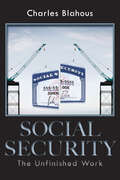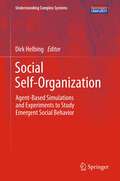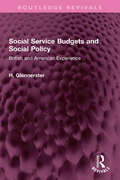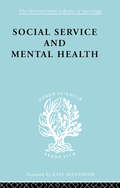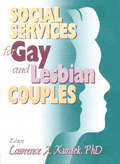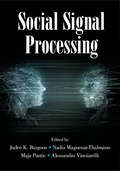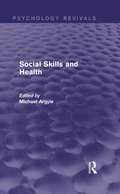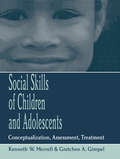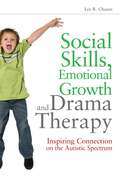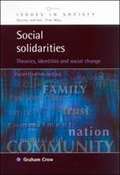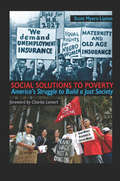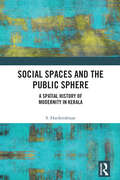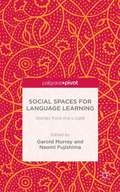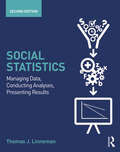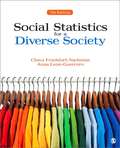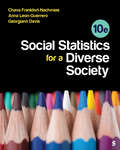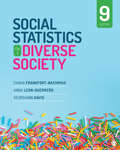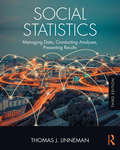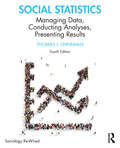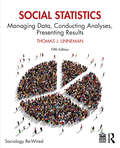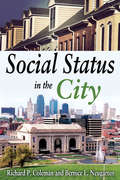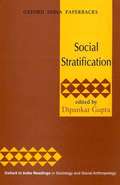- Table View
- List View
Social Security: The Unfinished Work
by Charles BlahousArguing that an equitable Social Security solution will be unattainable unless we bring stakeholders together around a common understanding of the facts and of the need to take action to address them, former White House adviser Charles Blahous presents some often misunderstood, basic factual background about Social Security. He discusses how it affects program participants and explains the true demographic, economic, and political factors that threaten its future efficacy.
Social Self-Organization
by Dirk HelbingWhat are the principles that keep our society together? This question is even more difficult to answer than the long-standing question, what are the forces that keep our world together. However, the social challenges of humanity in the 21st century ranging from the financial crises to the impacts of globalization, require us to make fast progress in our understanding of how society works, and how our future can be managed in a resilient and sustainable way. This book can present only a few very first steps towards this ambitious goal. However, based on simple models of social interactions, one can already gain some surprising insights into the social, ``macro-level'' outcomes and dynamics that is implied by individual, ``micro-level'' interactions. Depending on the nature of these interactions, they may imply the spontaneous formation of social conventions or the birth of social cooperation, but also their sudden breakdown. This can end in deadly crowd disasters or tragedies of the commons (such as financial crises or environmental destruction). Furthermore, we demonstrate that classical modeling approaches (such as representative agent models) do not provide a sufficient understanding of the self-organization in social systems resulting from individual interactions. The consideration of randomness, spatial or network interdependencies, and nonlinear feedback effects turns out to be crucial to get fundamental insights into how social patterns and dynamics emerge. Given the explanation of sometimes counter-intuitive phenomena resulting from these features and their combination, our evolutionary modeling approach appears to be powerful and insightful. The chapters of this book range from a discussion of the modeling strategy for socio-economic systems over experimental issues up the right way of doing agent-based modeling. We furthermore discuss applications ranging from pedestrian and crowd dynamics over opinion formation, coordination, and cooperation up to conflict, and also address the response to information, issues of systemic risks in society and economics, and new approaches to manage complexity in socio-economic systems. Selected parts of this book had been previously published in peer reviewed journals.
Social Service Budgets and Social Policy: British and American Experience (Routledge Revivals)
by H. GlennersterFirst published in 1975, Social Service Budgets and Social Policy compares the attempts by British and US federal governments to plan and control social service expenditure. It concentrates on education, health and social security spending and begins by discussing the contrasting theories of how resource allocation does and ought to work. Then, having compared the broad economic, political and policy contexts within which social planners in the two countries have to work, it scrutinises in particular their attempts at forward planning, output budgeting and programme evaluation. It argues for more explicit and informed decisions about priorities, but as part of an open political process. This book will be of interest to students of economics, sociology and social policy.
Social Service and Mental Health: An Essay on Psychiatric Social Workers (International Library of Sociology #Vol. 266)
by M. Ashdown S. Clement BrownFirst published in 1998. Routledge is an imprint of Taylor & Francis, an informa company.
Social Services for Gay and Lesbian Couples
by Lawrence A KurdekHere is an essential resource filled with advice for providing social services to gay and lesbian couples. Despite myths to the contrary, many gay men and lesbians form long-term couples relationships. Unfortunately, many professionals working in the area of social services lack training with regard to the special needs of gay/lesbian couples. Social Services for Gay and Lesbian Couples helps fill this gap by providing information on diverse aspects of gay and lesbian domestic partnerships for social services workers.The contributing authors highlight the unique characteristics of gay and lesbian couples relationships and provide valuable information on the special social services these couples may need. Social Services for Gay and Lesbian Couples includes the results of a survey that divulge basic, descriptive information on the nature of gay and lesbian couples. These in-depth statistics reveal couples’perspectives on relationship length, commitment, and quality, terms of address for partners, finances, relationship experience, discrimination, living situation, sex, first meetings, support and challenges for the relationship, children, legal arrangements, and concerns about HIV and AIDS. In addition to revealing specific information about gay and lesbian couples, Social Services for Gay and Lesbian Couples also explores the therapeutic implications of this knowledge for social service providers. Chapters discuss specific situations in gay and lesbian relationships about which social workers should be informed, such as the factors involved in the formation of lesbian identities and issues encountered by gay couples when one partner is HIV-infected and the other is not. Also addressed are the special needs of gay or lesbian couples who wish to be parents, complete with descriptions of innovative services and the names, addresses, and phone numbers of national organizations that provide resources for gay or lesbian parents.
Social Signal Processing
by Nadia Magnenat-Thalmann Judee K. Burgoon Alessandro Vinciarelli Maja Pantic"Social Signal Processing is the first book to cover all aspects of the modeling, automated detection, analysis, and synthesis of nonverbal behavior in human-human and human-machine interactions. Authoritative surveys address conceptual foundations, machine analysis and synthesis of social signal processing, and applications. Foundational topics include affect perception and interpersonal coordination in communication; later chapters cover technologies for automatic detection and understanding such as computational paralinguistics and facial expression analysis and for the generation of artificial social signals such as social robots and artificial agents. The final section covers a broad spectrum of applications based on social signal processing in healthcare, deception detection, and digital cities, including detection of developmental diseases and analysis of small groups. Each chapter offers a basic introduction to its topic, accessible to students and other newcomers, and then outlines challenges and future perspectives for the benefit of experienced researchers and practitioners in the field"--
Social Skills and Health (Psychology Revivals)
by Michael ArgyleThe efficiency of an organization and the well-being of those working within it are often dependent to a large extent on the social skills deployed by certain key personnel. The analysis of these skills and the training of people in their use had reached a stage of considerable sophistication. Originally published in 1981, this volume, edited by the foremost authority in the field, presents a wealth of ideas and information on how best to employ social skills training in health and welfare agencies that are still relevant today. The introduction describes the processes of social interaction in which social skills consist, introduces the social-skill model and shows how social competence is assessed and how the most effective social skills are discovered. Subsequent chapters deal with the social skills required of nurses, doctors, psychotherapists, social workers and those charged with child-rearing. There is a chapter which gives an account of the social skill problems of mental patients and the extent to which social inadequacy is responsible for their other problems. The final chapter discusses the main techniques of social skills training, and reviews their success in the light of follow-up studies. The book will be of historical value to all those concerned with the training and performance of personnel within the health related professions and to those with an academic interest in the psychology of human relations.
Social Skills of Children and Adolescents: Conceptualization, Assessment, Treatment
by Kenneth W. Merrell Gretchen GimpelThis scholarly yet highly readable and practical text systematically covers the importance, development, assessment, and treatment of social skills of children and adolescents. Combining scientific rigor with a highly approachable and readable style of writing to create a practical and unique book, this volume provides a comprehensive overview of the increasingly important topic of child and adolescent social skills. A wide variety of tables, figures, and practical step-by-step guides enhance the material presented, making it particularly useful for practitioners while offering an extensive array of recent research and models of interest to researchers. The authors present a solid foundation of scientific knowledge written in a manner accessible to nonscientists and having ample practical implications and examples for educational and clinical practice. The book is divided into two parts--the first features a foundation for conceptualizing and assessing child and adolescent social skills, whereas the second focuses on the arena of intervention. An up-to-date and unique addition to the literature, this volume will be of interest to professionals who work with or study children across several disciplines including school and clinical child psychology, special education, counseling, and social work. Although many books and other professional materials on the social competence of children and adolescents are presently available, the knowledge regarding these social skills is expanding rapidly, and there is a tremendous need to keep it current. This book helps meet this need by not only synthesizing a great deal of recent work in the field, but also by providing new information and evidence that has not yet been published. It also bridges an important gap that sometimes exists between research and practice. For instance, some books on child and adolescent social skills are clearly written for the academician or researcher, and may have little apparent application for the clinician or practitioner. Other materials are written as practical assessment or intervention guides for the clinician/practitioner, yet sometimes lack supporting evidence and rationale. This book is aimed at both arenas.
Social Skills, Emotional Growth and Drama Therapy
by Lee R. ChasenDrama therapy provides valuable opportunities for children on the autism spectrum to interact and connect with others in a fun, supportive environment. The innovative model of drama therapy described in this book is rooted in neuroscience, and designed specifically to develop social, emotional and expressive language skills in children with autism spectrum disorders (ASD). Lee R. Chasen provides an accessible explanation of the theoretical foundations, concepts and techniques that make up the approach, and describes in detail a thirty-session drama therapy program which uses creative and playful tools such as guided play, sociometry, puppetry, role-play, video modeling and improvisation. Scenarios drawn from his own practice provide useful insights into the practicalities of setting up and running such a program, as well as into how children's social, emotional and expressive language skills deepen through their immersion in this unique approach. This book will be of interest to drama and creative arts therapists, as well as teachers, school psychologists, counsellors and other professionals who work with children with autism spectrum disorders.
Social Solidarities: Theories, Identities And Social Change
by Graham CrowSocial solidarity is important in many areas of our lives, or at least in how we wish our lives to be. Family and kinship relationships, community life, trade union activity and the identity politics of new social movements are just some of the numerous ways in which social solidarity features in contemporary social arrangements. This book explores the ways in which people strive to come together and act as a coherent, unified force. It considers the arguments of those who claim that solidarity is increasingly fragile, and of those who are concerned to revitalise solidarities in our unsettled societies. The author shows how social change can be understood in the context of the limitations as well as the potential of the pursuit of solidarity, drawing on research findings on social relationships in families, communities, and the post-communist world. Written with undergraduate students and researchers in mind, Social Solidarities will be an invaluable text for those studying social theory, and family, community or comparative sociology.
Social Solutions to Poverty: America's Struggle to Build a Just Society
by Charles C. Lemert Scott Myers-LiptonThe voices of famous and lesser known figures in America's quest to reduce poverty are collected for the first time in this comprehensive historical anthology. The book traces the most important ideas and contributions of citizens, activists, labour leaders, scholars, politicians, and governmental agencies to ensure American citizens the basics of food, housing, employment, education, and health care. The book follows the idea of poverty reduction from Thomas Paine's agrarian justice to Josiah Quincy's proposal for the construction of poorhouses; from the Freedmen's Bureau to Sitting Bull's demand for money and supplies; from Coxey's army of the unemployed to Jane Addams's Hull House; from the Civil Works Administration to Dr. Martin Luther King, Jr.'s call for an Economic Bill of Rights; and from William Julius Wilson's universal programme of reform to George W. Bush's armies of compassion.
Social Spaces and the Public Sphere: A Spatial-history of Modernity in Kerala
by S. HarikrishnanWhat can social spaces tell us about social relations in society? How do everyday social spaces like teashops, reading rooms, and libraries reify—or subvert—dominant social structures like caste and gender? These are the questions that this book explores through a study of modern Kerala. Using archival material, discourse analysis, participant observation, and personal interviews, this book traces the transformation of public spaces through the nineteenth and twentieth centuries. The volume focuses on how "modernity" has also been a struggle for access to public spaces, and non-institutional spaces like teashops, markets, public roads, temple grounds, reading rooms, and libraries have all been crucial to how political culture was shaped, and how dominant hegemonies—caste, class, or capital—have been challenged. It suggests that the secular public sphere that emerged in the last century in Kerala was a result of the constant negotiations between conflicting ideas which were put to test in these social spaces. At a time when digital spaces are fast replacing physical ones, this book is a timely reminder of the struggles that led to the emergence of secular public spaces in Kerala. It contributes to similar studies on public space that have emerged from other parts of the world over the last decades. A major contribution to understanding modern India, this book will be of interest to scholars and researchers of social history, political science, political sociology, gender studies, linguistics, and South Asian studies.
Social Spaces for Language Learning: Stories from the L-café
by Garold Murray Naomi FujishimaSocial Spaces for Language Learning.
Social Statistics
by Thomas J. LinnemanMany fundamentally important decisions about our social life are a function of how well we understand and analyze DATA. This sounds so obvious but it is so misunderstood. Social statisticians struggle with this problem in their teaching constantly. This book and its approach is the ally and support of all instructors who want to accomplish this hugely important teaching goal. This innovative text for undergraduate social statistics courses is, (as one satisfied instructor put it), a "breath of fresh air." It departs from convention by not covering some techniques and topics that have been in social stat textbooks for 30 years, but that are no longer used by social scientists today. It also includes techniques that conventional wisdom has previously thought to be the province of graduate level courses. Linneman's text is for those instructors looking for a thoroughly "modern" way to teach quantitative thinking, problem-solving, and statistical analysis to their students...an undergraduate social statistics course that recognizes the increasing ubiquity of analytical tools in our data-driven age and therefore the practical benefit of learning how to "do statistics," to "present results" effectively (to employers as well as instructors), and to "interpret" intelligently the quantitative arguments made by others. A NOTE ABOUT THE AUTHOR... At a recent Charter Day celebration, author Tom Linneman was awarded the Thomas Jefferson Teaching Award, the highest award given to young faculty members at the College of William and Mary. The citation for his award noted that Linneman has developed a reputation among his students as a demanding professor - but one who genuinely cares about them.
Social Statistics For A Diverse Society
by Anna Leon-Guerrero Chava Frankfort-NachmiasToday's students live in a world characterized by a growing diversity and richness of social differences. In the seventh edition of Social Statistics for a Diverse Society, authors Chava Frankfort-Nachmias and Anna Leon-Guerrero continue to help students learn statistics through real research examples related to the dynamic interplay of race, class, gender, and other social variables. Focusing on the constant intersections between local and global social concerns and methods of inquiry and investigation, this new edition continues to emphasize intuition and common sense while demonstrating the link between the practice of statistics and important social issues. In addition, guides for reading and interpreting the research literature help students understand key statistical concepts, while SPSS demonstrations and a rich variety of exercises help them hone their problem-solving skills.
Social Statistics for a Diverse Society
by Anna Leon-Guerrero Georgiann Davis Chava Frankfort-NachmiasSocial Statistics for a Diverse Society introduces students to social statistics and their importance in the workplace, in the media, and in being able to conduct or interpret research. This bestselling book integrates statistical techniques with a wide range of social issues related to the dynamic interplay of race, class, gender, and other social variables: students become proficient in statistical techniques while learning about social differences and inequality through substantive examples and real-world data. The authors use straightforward language to explain statistical concepts and emphasize intuition, logic, and common sense over rote memorization and derivation of formulas. The Tenth Edition includes fresh topical examples and exercises, as well as new General Social Survey datasets with step-by-step SPSS and Excel video demonstrations.
Social Statistics for a Diverse Society
by Anna Leon-Guerrero Georgiann Davis Chava Frankfort-NachmiasSocial Statistics for a Diverse Society introduces students to social statistics and their importance in the workplace, in the media, and in being able to conduct or interpret research. This bestselling book integrates statistical techniques with a wide range of social issues related to the dynamic interplay of race, class, gender, and other social variables: students become proficient in statistical techniques while learning about social differences and inequality through substantive examples and real-world data. The authors use straightforward language to explain statistical concepts and emphasize intuition, logic, and common sense over rote memorization and derivation of formulas. The Tenth Edition includes fresh topical examples and exercises, as well as new General Social Survey datasets with step-by-step SPSS and Excel video demonstrations.
Social Statistics for a Diverse Society
by Chava Frankfort-Nachmias Georgiann Davis Anna Y. Leon-GuerreroThe authors are proud sponsors of the 2020 SAGE Keith Roberts Teaching Innovations Award—enabling graduate students and early career faculty to attend the annual ASA pre-conference teaching and learning workshop. The Ninth Edition of Social Statistics for a Diverse Society continues to emphasize intuition and common sense, while demonstrating the link between the practice of statistics and important social issues. Recognizing that we live in a world characterized by a growing diversity and richness of social differences, best-selling authors Frankfort-Nachmias, Leon-Guerrero, and Davis help students learn key statistical concepts through real research examples related to the dynamic interplay of race, class, gender, and other social variables. The text also helps readers develop important skills such as problem-solving (through a rich variety of exercises), use of statistical software (both SPSS and Excel), and interpreting research literature. Included with this title: The password-protected Instructor Resource Site (formally known as SAGE Edge) offers access to all text-specific resources, including a test bank and editable, chapter-specific PowerPoint® slides.
Social Statistics for a Diverse Society
by Chava Frankfort-Nachmias Georgiann Davis Anna Y. Leon-GuerreroThe authors are proud sponsors of the 2020 SAGE Keith Roberts Teaching Innovations Award—enabling graduate students and early career faculty to attend the annual ASA pre-conference teaching and learning workshop. The Ninth Edition of Social Statistics for a Diverse Society continues to emphasize intuition and common sense, while demonstrating the link between the practice of statistics and important social issues. Recognizing that we live in a world characterized by a growing diversity and richness of social differences, best-selling authors Frankfort-Nachmias, Leon-Guerrero, and Davis help students learn key statistical concepts through real research examples related to the dynamic interplay of race, class, gender, and other social variables. The text also helps readers develop important skills such as problem-solving (through a rich variety of exercises), use of statistical software (both SPSS and Excel), and interpreting research literature. Included with this title: The password-protected Instructor Resource Site (formally known as SAGE Edge) offers access to all text-specific resources, including a test bank and editable, chapter-specific PowerPoint® slides.
Social Statistics: Managing Data, Conducting Analyses, Presenting Results (3rd Edition) (Sociology Re-Wired)
by Thomas J. Linneman<p>With a clear and engaging writing style and strong examples from the real world, this text covers current statistical techniques at an introductory level and emphasizes the clear presentation of results to a variety of audiences, making the course more useful to students and their careers. Interconnection features among chapters help students understand how all of the techniques fit together. Using varied data sets, the text features a highly rated companion website that includes videos of the author offering step-by-step explanations of how to carry out the techniques, interpret the results, and present them to varied audiences. <p>NEW TO THIS EDITION <p> <li>More inter-chapter connections have been added to improve students’ conceptual learning. <li>Several examples (on immigration, health, and civil rights) now permeate the text for easy comparison of techniques across chapters. <li>The section on managing data is considerably expanded to cover topics such as finding new sources of data, dealing with missing data, and how to combine data reliably. <li>Very current examples from the scholarly literature from criminology, education, and health show how researchers use each chapter’s techniques to tell compelling stories. <li>Instructors can choose from a variety of greatly expanded materials to enhance their lectures: engaging animations of key concepts; dynamic demonstrations of how statistics change in line with the data; short lectures on difficult-to-explain topics; and in-class exercises that will help students learn how to make sense of statistical results.</li></p>
Social Statistics: Managing Data, Conducting Analyses, Presenting Results (Sociology Re-Wired)
by Thomas J. LinnemanWith a clear, engaging writing style and fascinating examples using a variety of real data, this text covers the contemporary statistical techniques that students will encounter in the world of social research. It covers these techniques at an introductory level and carefully guides students through increasingly complex examples without intimidating them. Recurrent examples using four timely topics—health, immigration, income inequality, and everyday harassment—help students understand how the techniques fit together, and how to use the techniques in combination with one another. A superb author-created web resource accompanies the text. How to make clear presentations of research results is also a feature of the text. New to this edition: New research shows how the techniques has changed over time in the academic literature, showing students that social scientists really do use the statistical techniques the book teaches and giving them ample motivation to learn the techniques. Examples throughout the book use the most recent data from the General Social Survey. Four timely topics are threaded throughout the book: immigration, health, income inequality, and everyday harassment. Linneman uses these topics recurrently with different statistical techniques to illustrate how the techniques are related to one another. The new edition more explicitly emphasizes that the various techniques the students are learning are often used in combination with one another. After introducing a new technique and showing how to use it on its own, Linneman then systematically offers examples of how to combine that technique with techniques students learned in previous chapters. Most of the literature examples that end each chapter are new and use very recent research from top academic journals (three quarters from 2015 or later, nearly half from 2019). They feature research that covers timely topics such as Black Lives Matter, transgender health, social media, police behavior, and climate change. The SPSS demonstrations are completely redone, both in the book and on the website’s demonstration videos, using more recent data. Linneman applies his experience teaching his own students SPSS (knowing where students get confused) to clarify his explanations in these demonstrations.
Social Statistics: Managing Data, Conducting Analyses, Presenting Results (Sociology Re-Wired)
by Thomas J. LinnemanWith a clear, engaging writing style and fascinating examples using a variety of real data, this text covers the contemporary statistical techniques that students will encounter in the world of social research. It covers these techniques at an introductory level and carefully guides students through increasingly complex examples without intimidating them. Recurrent examples using four timely topics—immigration, income inequality, the distribution of household labor, and health (including attitudes toward doctors and pandemic restrictions)—help students understand how the techniques fit together and how to use the techniques in combination with one another. A superb author-created web resource accompanies the text. How to make clear presentations of research results is also a feature of the text.New to this edition: Most of the literature examples that end each chapter are new and use very recent research from top academic journals (over half of the new literature examples are from 2023 or 2024). They feature research about some of the most pertinent and provocative social issues of the day: political polarization, conspiracy beliefs, mental health, transgender support, racial stereotypes, vaccine refusal, sexual harassment, and numerous facets of the COVID-19 pandemic. Examples throughout the book use the most recent data from the General Social Survey. Four timely topics are threaded throughout the book: immigration, income inequality, the distribution of household labor, and health. Linneman uses these topics recurrently with different statistical techniques to illustrate how the techniques are related to one another. The new edition more explicitly emphasizes that the various techniques the students are learning are often used in combination with one another. Linneman carefully scaffolds the techniques, introducing a new technique and then showing how this technique can be combined with techniques taught in previous chapters. He does this with a new emphasis on psychologically supporting students who might be trepidatious about their newfound statistical skills.
Social Status in the City
by Bernice Neugarten"Social Status in the City presents a scientific method for measuring social status in urban settings - the Index of Urban Status (IUS). The authors show how the index and the concepts of status on which it is based were derived by describing the procedures used in studying the social structure of a particular Midwestern city. Richard P. Coleman modified the IUS when he was employed in commerce research studies of social class phenomena in American cities.A social class is a group of people who are judged by members of the community as equal to one another in social prestige. They are believed to be either superior or inferior in prestige and acceptability to other groups who constitute the social classes that are below or above them. By this definition, Yankee City, Deep South, Jonesville, Kansas City - and presumably every community in the U.S. - can all be described as having social class systems. This book is a case study aimed at larger theoretical importance.The study should be considered in the context of sociology's concerns with problems of urban stratification, the characteristics of various social class groups, and the ways these groups change over time. In this context, the book makes a contribution to social science methods as well as observation. The authors have followed in the tradition of W. Lloyd Warner and others who have attempted to understand the status structures of whole communities. This classic volume has brilliantly stood the test of time."
Social Stigma: The Psychology of Marked Relationships
by Edward E. JonesSocial Stigma: The Psychology of Marked Relationships.
Social Stratification
by Dipankar GuptaThis work discusses social stratification in India with an interdisciplinary approach. It contains both classical and new writing on caste. It profiles the variations and the social importance of this system.
